#Yarkovsky
Text
Yarkovsky Effect
Introduction
The Yarkovsky Effect is the force acting on a rotating body in space caused by the anisotropic emission of thermal photons (which carry momentum). This effect is named after the engineer Ivan Osipovich Yarkovsky, who first proposed the idea. This effect plays a significant role in the dynamics of small celestial bodies, such as asteroids and meteoroids.
Understanding the Yarkovsky…
View On WordPress
0 notes
Text






Sunflower Flag Wars: Round 2, Bracket 3
10 notes
·
View notes
Link
There are millions of asteroids floating around the solar system. With so many of them, it should be no surprise that some are weirdly configured. A recent example of one of these weird configurations was discovered when Lucy, NASA’s mission to the Trojan asteroids, passed by a main-belt asteroid called Dinkinesh. It found that Dinkinesh had a “moon” – and that moon was a “contact binary”. Now known as Selam, it is made up of two objects that physically touch one another through gravity but aren’t fully merged into one another. Just how and when such an unexpected system might have formed is the subject of a new paper by Colby Merrill, a graduate researcher at Cornell, and their co-authors at the University of Colorado and the University of Bern. The paper, in particular, looks at when the system might have formed and does so through modeling. A theory in asteroid formation called the binary Yarkovsky-O’Keefe-Radzievskii-Paddack effect, which, since no one wants to say the full name, is shortened to the acronym BYORP. This model explains how binary asteroid systems happen in the first place. Essentially, the asteroid speeds up its rotation due to radiation pressure. Eventually, due to those rotational forces, it gets to a point where its gravity is no longer capable of holding all of its material on its surface, and some of that material is ejected out into space, eventually coalescing into a “moon” for the slightly larger asteroid. Video from NASA Goddard showing the image from Lucy that found Selam.Credit – NASA Goddard YouTube Channel Dinkinesh isn’t a “large” asteroid by any measure – at its widest point, it only measures about 790 meters in diameter. It’s also named after the Amharic word for Lucy; the fossil remains of a potential human ancestor found in Ethiopia and the namesake of NASA’s mission. Its satellite, Salem, is the Amharic word for “peace,” but another fossil set found in 2000 which, though that of a child, predated Lucy’s by 100,000 years. But it is even smaller than Dinkinesh – only about 220 m at its widest point. But Selam actually has two widest points because it is shaped in what is technically called a bilobate but is more commonly thought of as a “dumbbell” shape. This might be partially due to another force that influences the formation of asteroids—tides. Traditionally, people think of tides as caused by our Moon moving around the Earth. However, tides can also happen on the insides of asteroids when there is a gravitational force on a small body by an even smaller one that happens to be nearby. For example, Selam induces tides on Dinkinesh, and understanding how the two developed together requires understanding how those tidal forces played out. Close up of Dinkinesh & Selam from Lucy.Credit – NASA/Goddard/SwRI/John Hopkins APL/NOIRLab/Brian May/Claudia Manzoni Modeling both tidal forces and the BYROP acceleration process is complex mathematically. This is especially true because the inputs to the equations used to model them contain plenty of uncertainties. Luckily, there is a mathematical technique to help with that. The Monte Carlo method uses statistics to find a “correct” answer by varying the inputs to equations and randomly sampling the results. The authors used this technique to determine how long the Dinkinesh / Selam system had been in orbit around each other, using inputs like each object’s sizes and orbital speeds. They came up with an answer of between 1 and 10 million years – not very long in the grand scheme of the solar system’s evolution. Given that binaries are thought to make up at least 15% of near-Earth asteroids, and contact binaries make up between 14% and 30% of small bodies that are still larger than 200 m, studying these kinds of unexpected systems could prove fruitful in understanding how asteroids more generally are formed. As the paper mentions, more work is needed, especially an analysis of the craters present on Selam, which could provide an alternative view of its age. Given that we only just discovered this binary system by chance in November 2023, that data, and much else from the Lucy mission, will doubtless be forthcoming soon. Fraser discusses the discovery of Selam. Learn more:Merrill et al. – Age of (152830) Dinkinesh I Selam constrained by secular tidal-BYORP theoryUT – Contact Binary Asteroids are Common, but We’ve Never Seen One Form. So Let’s Make OneUT – Awesome Radar Images Reveal Asteroid 2014 HQ124’s Split PersonalityUT – What? Wow! That New Asteroid Image from Lucy Just Got Even More Interesting Lead Image:Dinkinesh and Selam in situ via a Lucy snapshot.Credit – NASA/Goddard/SwRI/John Hopkins APL The post Finding The Age Of A Contact Binary “Moon” appeared first on Universe Today.
0 notes
Text
#aFactADay2024
#1231: the Yarkovsky–O'Keefe–Radzievskii–Paddack effect, or the YORP effect for short, is an effect on things like asteroids, which are smallish and uneven. as a layperson, it's basically the light equivalent of a wind turbine, i think: as photons hit a surface, they impart an impulse (ie they transfer momentum), and because the surface of the astronomical body slants in some places more than others, the reactionary force (as well as infrared radiation) isn't parallel to the incident force, causing a net torque. the person who named it claimed to do so after the four scientists who enabled the effect to be discovered, but really i think they just went "yorp" and retroactively found four people in the right field with the right initials.
yorp
1 note
·
View note
Text
Yarkovsky and YORP effects - Scholarpedia
The Yarkovsky effect describes a small but significant force that affects the orbital motion of meteoroids and asteroids smaller than 30-40 kilometers in diameter. It is caused by sunlight; when these bodies heat up in the Sun, they eventually re-radiate the energy away as heat, which in turn creates a tiny thrust.






0 notes
Text
Meaning of meteoroid

(9) In November 2004 the lunar phase was adequate to observe lunar impact flashes at the time of the Leonid meteor shower, as it was the case in 19, because a large number of meteoroidal impacts were expected to hit the night part of the Moon visible from Earth. (8) Among the different forms of meteoroidal disintegration in the atmosphere described above, the quasi-continuous fragmentation is of greatest interest. (7) The moon, after all, had acted as a gravitational trap for meteoroidal material accumulated from space over many eons. (6) If you have a small telescope, within your grasp are many thousands of craters, ranging from the grand walled plains to meteoroidal and asteroidal impact craters with their bright ray systems. (5) The term ‘space debris’ in its largest sense includes all naturally occurring remains of solar and planetary processes: interplanetary dust, meteoroids, asteroids, and comets. (4) It was interpreted as a meteoroidal bolide followed by probable meteorite fall. (3) Once the meteoroids enter the Earth's atmosphere, they are known as meteors and become visible due to the friction caused by air molecules slamming against the surface of the high-velocity particle. (2) However, from time to time, comets suddenly get brighter, and one possible explanation for this is that the comet has struck a small meteoroid in space perhaps a small lump of rock, 10 cm or a metre in size. That is not too worrying, because these are likely to be less devastating if they do hit.(1) Whether a meteoroid makes it to Earth's surface or not depends on many factors including the mass, initial velocity, angle of entry, composition, and shape of the body. The vast majority of Earth’s surface is unpopulated, so the odds of something landing on your head are small.Īsteroid monitors believe they have identified 90 per cent of the really huge rocks with the potential to hit Earth, but the smaller asteroids are, the harder it is to spot them. However, in 1911, a 40-kilogram boulder from Mars struck and killed a dog in Egypt, and in Uganda a boy was hit, but not seriously injured, by a small meteorite in 1992. There are no confirmed reports of a human death being caused by rocks from space. Has anyone ever been killed by a meteoroid impact? The most damaging meteorite strike in recent times was the Tunguska event, a megaton-scale explosion that destroyed a swathe of Siberian forest in 1908. Large asteroids are expected to hit Earth once every 2000 years. Larger impacts are rarer: NASA says that an object the size of a car should hit Earth every year. Tiny rocks enter Earth’s atmosphere nearly every day, but burn up unnoticed. There have been no confirmed meteorites originating in this way from Mercury or Venus, because they would have to fight against the Sun’s gravitational pull to reach us. Larger asteroids hitting the moon or Mars can also send shrapnel our way. This can build up over millions of years to give asteroids significant speed. Collisions within the belt can send objects hurtling towards Earth, and heat from the sun can dislodge smaller rocks by warming them more on one side, resulting in a gradual push called the Yarkovsky effect. They range in size from nearly 1000 kilometres across, to microscopic dust particles. Most are from the asteroid belt, a jumble of rocks between the orbits of Mars and Jupiter. Anything that survives the impact is a meteorite. When an asteroid or meteoroid enters the atmosphere and streaks through the sky, it then becomes known as a meteor. Small asteroids are also called meteoroids. Roughly speaking, an asteroid is a relatively small body (that isn’t a comet), usually rocky or metallic, composed of dirt and ice. What is the difference between a meteor, a meteorite, a meteoroid and an asteroid? Most meteorites are bits of asteroid, which are themselves leftovers from the formation of the solar system.

0 notes
Text
Nuovi dati dalla sonda Osiris-Rex, pericolo asteroide Bennu
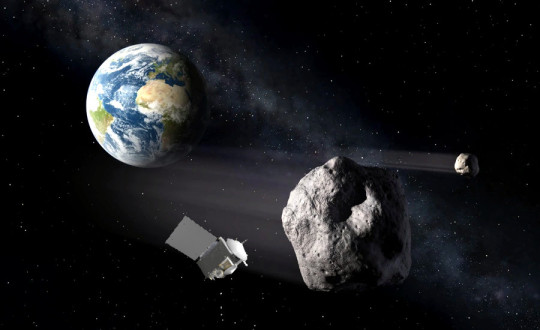
Nuovo calcolo di probabilità d’impatto per Bennu, è fra i due asteroidi con più alto rischio d'impatto complessivo.
«Non abbiamo mai modellato la traiettoria di un asteroide con questa precisione prima d'ora», spiega Davide Farnocchia della Nasa, primo autore di un nuovo studio che ha ricalcolato con i dati ottenuti dalla sonda Osiris-Rex le orbite dell’asteroide Bennu per i prossimi due secoli. Fino al 2135 possiamo stare tranquilli; dopo, ha qualche piccola possibilità d’infilare la porta gravitazionale sbagliata.
Il 24 settembre 2023 è previsto l’arrivo sulla terra di un’abbondante manciata di regolite carbonacea che la sonda Nasa Osiris-Rex ha raccolto nell’ottobre 2020 direttamente dalla superficie dell’asteroide Bennu. Sempre il 24 settembre, ma molti anni dopo, precisamente nel 2182, la Terra rischia di trovarsi recapitata a domicilio tutta la massa dell’asteroide da mezzo chilometro di diametro. Vediamo perché.
L’asteroide (101955) Bennu, scoperto nel 1999 e ripetutamente osservato con telescopi ottici e radar, è un Near-Earth Object potenzialmente a rischio di intersecare la sua orbita con quella terrestre. Anzi, nella scala Palermo – usata dagli astronomi per valutare il rischio di impatto – risulta uno dei due oggetti con maggiore probabilità complessiva di causare danni alla Terra.
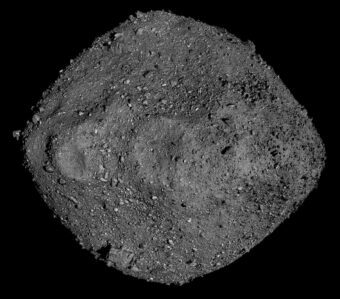
L’asteroide Bennu in un mosaico d’immagini riprese dalla sonda Nasa Osiris-Rex. Crediti: Nasa/Goddard/University of Arizona
Un nuovo studio, pubblicato sulla rivista Icarus, ha ora raffinato notevolmente le previsioni su un possibile incontro tra Bennu e il nostro pianeta, basandosi sulle informazioni raccolte proprio dalla missione Osiris-Rex negli oltre due anni in cui ha visitato Bennu. Osiris-Rex ha indagato da vicino le dimensioni, la forma e la composizione dell’asteroide, studiando la rotazione e la traiettoria orbitale molto più in dettaglio di quanto avrebbe potuto fare qualunque telescopio terrestre. Questo ha permesso ora di stimare con maggiore precisione il suo percorso nel prossimo paio di secoli.
Il nuovo studio ha determinato una probabilità complessiva d’impatto entro l’anno 2300 di 1 su 1750 (o 0.057 per cento), mentre – come si diceva – il 24 settembre 2182 risulterebbe la singola data più significativa in termini di potenzialità, con una probabilità d’impatto di 1 su 2700 (o circa 0.037 per cento).
«I dati di Osiris-Rex ci danno informazioni molto più precise, possiamo testare i limiti dei nostri modelli e calcolare la traiettoria futura di Bennu con un altissimo grado di certezza fino al 2135», commenta il primo autore dello studio Davide Farnocchia, del Center for Near Earth Object Studies (Cneos) della Nasa. «Non abbiamo mai modellato la traiettoria di un asteroide con questa precisione prima d’ora».
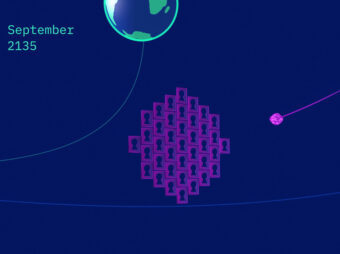
Illustrazione dei “buchi della serratura gravitazionali” in cui potrebbe infilarsi Bennu nel 2135. Crediti: Nasa/Goddard
Nel 2135 l’asteroide Bennu si avvicinerà molto alla Terra. Pur senza rappresentare alcun rischio in quel momento, per gli scienziati è fondamentale riuscire a capire il più accuratamente possibile in che modo la gravità terrestre altererà il percorso dell’asteroide intorno al Sole. In particolare, se il corpo spaziale percorrerà alcune traiettorie specifiche, passanti attraverso determinati punti chiamati “buchi della serratura gravitazionali” (gravitational keyhole), che lo metterebbero in rotta di collisione con Terra durante un’orbita futura.
Per calcolare esattamente dove si troverà Bennu durante il suo passaggio ravvicinato del 2135 e se possa passare o meno attraverso un gravitational keyhole, Farnocchia e il suo team hanno valutato vari tipi di forze che, per quanto piccole, possono influenzare a lungo andare il percorso dell’asteroide mentre orbita attorno al Sole.
Tra queste forze, il calore del Sole medesimo gioca un ruolo cruciale grazie a un fenomeno chiamato effetto Yarkovsky, che, con la rotazione del corpo fra “giorno” e “notte”, fa disperdere l’energia assorbita dal Sole nello spazio, generando una piccola quantità di spinta sull’asteroide. Con la prossima disponibilità di un campione della superficie di Bennu, si potranno determinare ancora più accuratamente le proprietà termiche dell’asteroide.
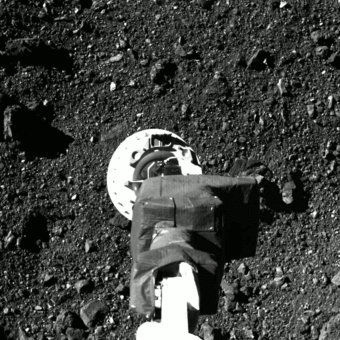
Manovra di campionamento su Bennu eseguita da Osiris-Rex. Crediti: Nasa/Goddard/University of Arizona
«L’effetto Yarkovsky agisce su asteroidi di tutte le dimensioni e, sebbene sia stato misurato per una piccola frazione della popolazione di asteroidi da lontano, Osiris-Rex ci ha dato la prima opportunità di misurarlo in dettaglio mentre Bennu viaggiava intorno al Sole», spiega Steve Chesley del Jpl Nasa, fra gli autori del nuovo studio. «L’effetto su Bennu è equivalente al peso di tre acini d’uva che agiscono costantemente sull’asteroide: minuscolo, sì, ma significativo quando si determinano le future possibilità di impatto di Bennu nei decenni e nei secoli a venire».
Il gruppo di ricerca ha considerato anche molte altre forze perturbanti, tra cui la gravità del Sole, dei pianeti, delle loro lune e di oltre 300 altri asteroidi, la resistenza causata dalla polvere interplanetaria, la pressione del vento solare e gli eventi di espulsione di particelle da Bennu medesimo.
I ricercatori hanno anche valutato la forza esercitata da Osiris-Rex durante l’esecuzione del suo evento di raccolta campioni Touch-And-Go del 20 ottobre 2020, per vedere se avesse potuto alterare leggermente l’orbita di Bennu. Sono state confermate le stime teoriche, secondo le quali il piccolo tocco del campionatore avrebbe avuto un effetto trascurabile.
Per saperne di più: Leggi su Icarus l’articolo “Ephemeris and hazard assessment for near-Earth asteroid (101955) Bennu based on OSIRIS-REx data”, di Davide Farnocchia, Steven R. Chesley, Yu Takahashi, Benjamin Rozitis, David Vokrouhlický, Brian P. Rush, Nickolaos Mastrodemos, Brian M.Kennedy, Ryan S. Park, Julie Bellerose, Daniel P. Lubey, Dianna Velez, Alex B. Davis, Joshua P. Emery, Jason M. Leonard, Jeroen Geeraert, Peter G. Antreasian e Dante S. Lauretta
Guarda il servizio video di MediaInaf Tv:
Read the full article
#asteroide#asteroidi#Astronomia#bennu#Cneos#DavideFarnocchia#effettoYarkovsky#gravitationalkeyhole#gravitazione#impatto#meteorite#NEAR-EARTHOBJECT#NEO#News Asteroidi#Osiris-Rex#portagravitazionale#Yarkovsky
1 note
·
View note
Text
DO ASTEROIDS HIT THE SUN??
Blog# 153
Wednesday, December 29th, 2021
Welcome back,
No asteroids have ever been observed to hit the Sun, but that doesn't mean that they don't! Asteroids are normally content to stay in the asteroid belt between Mars and Jupiter, but occasionally something nudges them out of their original orbits, and they come careening into the inner solar system. The "something" that changes the asteroid orbits is often thought to be the Yarkovsky effect. It is known that Jupiter has a strong effect on the asteroid belt.

Jupiter's gravity interacts with the Belt to form the Kirkwood gaps. Orbits within in a Kirkwood gap are not stable, and any asteroid whose orbit wanders into such a region will eventually get pulled into a different orbit, which may take it into the inner solar system. Therefore, the Kirkwood gaps have almost no asteroids. In addition to Jupiter's influence, occasional random impacts within the belt probably send asteroid pieces flying in toward the inner solar system.

Once they are on their way in toward the Sun, you might think that they should be guaranteed to hit the Sun, but that's not the case! It is actually difficult for something that is orbiting to fall all the way into the Sun. This is because of a property of orbiting objects called angular momentum. Angular momentum is a sort of measure of how much something is rotating around a central point. The reason that this is important is that one of the fundamental principles of physics is that angular momentum must be conserved.

For something to fall into the Sun, it has to lose nearly all of its angular momentum somehow, so that it is falling straight at the Sun. If it is off just slightly, instead of falling in, the asteroid will just fall very close, and then slingshot back out far from the Sun. It is probably quite rare for an asteroid to lose all of its angular momentum and fall straight into the Sun. However, there might be quite a few that lose enough to get close to the Sun and vaporize.

As I mentioned, we have never seen an asteroid come close to the Sun and vaporize. That's because asteroids are small rocks or pieces of metal, and even when they are being vaporized they are hard to see. Comets, on the other hand, give off huge glowing plumes of gas when they get close to the Sun, making them very easy to spot. The SOHO satellite has detected more than 1100 comets known as "sun grazers." These are comets that get close enough to the Sun to glow very brightly and show up in the SOHO images. Some of them disintegrate while others survive the close call and sail back out to the outer solar system until their next orbit brings them back. Check the SOHO Comets website for more information.
Originally published on curious.astro.cornell.edu
COMING UP!!
(Saturday, January 1st, 2022)
“WHY DOES THE MOON HAVE CRATERS??”
#Astronomy#astronomylover#astronomyclub#astronomyfacts#outer space#spacecraft#spaceX#space#universe#alternate universe#Parallel Universe#white universe#The Sun#sunspots#moon mars#Dark Matter#antimatter#strange matter
25 notes
·
View notes
Photo










What Are The Real Odds Of ‘Doomsday’ Asteroid Apophis Striking Earth In 2068?
“Discovered in 2004, Apophis presently orbits the Sun every 323 days. Initial measurements indicated Apophis had a 1-in-37 chance of impacting Earth in 2029. That's untrue; Apophis will miss Earth by 47,000 km (29,000 miles), with gravity drastically altering its orbit thereafter. Newly acquired Subaru telescope observations of Apophis revealed a surprise: the Yarkovsky effect. Sunlight heated the rotating, irregular asteroid, causing unexpected accelerations. Prior odds of a 2068 collision were estimated at 1-in-150,000; new odds will require a reanalysis.”
Have you heard that potentially hazardous asteroid Apophis, which was once touted as a potential threat in 2029, is now posing a threat for the year 2068?
Although many outlets are reporting this, it’s really unfair. We’ve learned something new about its orbit, and that means we need to recalculate our future odds of a collision; that doesn’t mean a collision is likely in 2068.
Come get the full story on what we honestly know about this near-Earth object, and what our options are if we find there’s a bigger threat than we think there is today.
184 notes
·
View notes
Photo

The likelihood of a collision with the Earth asteroid Apophis in 2068 is much higher than previously thought.
Asteroid "Apophis" was first noticed by astronomers back in 2004. Shortly thereafter, the researchers identified its orbit and found that the 340-meter-wide asteroid would pass close to Earth in 2029 and then again in 2068. Further research showed that the probability of an asteroid colliding with Earth is small, but the researchers did not take into account the Yarkovsky effect.
2 notes
·
View notes
Text
Jorge Antonio Pérez Hernández, a doctoral candidate of the Institute of Physical Sciences (ICF) of the National Autonomous University of Mexico (UNAM), has been granted the Raynor L. Duncombe 2020 Student Research Prize that awards the most outstanding astronomers and that includes institutions endorsed by the National Aeronautics and Space Administration (NASA).
He obtained the recognition in Dynamical Astronomy Research thanks to his studies on the Apophis asteroid, a rocky celestial body discovered in 2004 with an approximate diameter of 400 meters that caused a lot of concern back then for it was thought there was a high probability of it crashing with Earth in 2029.
“Its collision against our planet has been currently dismissed for that year, however, there are still possibilities starting in 2060,” as explained by the UNAM student regarding his investigation, which will also part of his dissertation.
Pérez Hernández is the third Latin American student who receives this award created in 1995 by the Division of Dynamical Astronomy of the American Astronomical Society.
This year's edition included the participation of nearly 60 students from universities like Yale, Colorado, Maryland, and Caltech, among others.
“The prize means to give Mexico and the UNAM a great name. It’s important that, as students, we focus on big goals and challenges. We must dare to play at the level of other institutions that make high-quality research because that is the UNAM’s level,” said the award winner.
The student, along with the support from his tutor, Luis Benet Fernández, who is a member of the General Direction of Computing and Information Technologies and Communication of the UNAM, resorted to computing calculations to understand the “Yarkovsky Effect,” which disrupts the orbit of the Apophis asteroid due to solar radiation, accumulated for a specific period, based on optical and radar observations.
Jorge Antonio Pérez Hernández, a doctoral candidate of the Institute of Physical Sciences (ICF) of the National Autonomous University of Mexico (UNAM), has been granted the Raynor L. Duncombe 2020 Student Research Prize that awards the most outstanding astronomers and that includes institutions endorsed by the National Aeronautics and Space Administration (NASA).
He obtained the recognition in Dynamical Astronomy Research thanks to his studies on the Apophis asteroid, a rocky celestial body discovered in 2004 with an approximate diameter of 400 meters that caused a lot of concern back then for it was thought there was a high probability of it crashing with Earth in 2029.
“Its collision against our planet has been currently dismissed for that year, however, there are still possibilities starting in 2060,” as explained by the UNAM student regarding his investigation, which will also part of his dissertation.
Pérez Hernández is the third Latin American student who receives this award created in 1995 by the Division of Dynamical Astronomy of the American Astronomical Society.
This year's edition included the participation of nearly 60 students from universities like Yale, Colorado, Maryland, and Caltech, among others.
“The prize means to give Mexico and the UNAM a great name. It’s important that, as students, we focus on big goals and challenges. We must dare to play at the level of other institutions that make high-quality research because that is the UNAM’s level,” said the award winner.
The student, along with the support from his tutor, Luis Benet Fernández, who is a member of the General Direction of Computing and Information Technologies and Communication of the UNAM, resorted to computing calculations to understand the “Yarkovsky Effect,” which disrupts the orbit of the Apophis asteroid due to solar radiation, accumulated for a specific period, based on optical and radar observations.
“Determining it is fundamental to predict the movement of the asteroid and assess the risk of it crashing with Earth,” asserted Pérez Hernández in a release published by the UNAM. These results match other reports about the “Yarkovsky Effect,” which is studied by two teams in the world: the University of Pisa and the Center for Near-Earth Objects Studies of Caltech’s Jet Propulsion Laboratory.
The Mexican student also acknowledged the support he received from the UNAM’s supercomputing area and the ICF: “We are very grateful with those in charge of the Miztli supercomputer because this research was highly demanding in computing terms; Miztli was essential to achieve the results and being able to compete against institutions endorsed by NASA,” he added.
After Pérez Hernández sent a recording about his research, he partook in a Q&A session with experts from the universities of Princeton, Toronto, and Colorado, who were in charge of evaluating him. Along with him, another three students from Yale, Cornell, and Colorado were awarded.
1 note
·
View note
Text

Sunflower Flag Wars: Round 1
The next tournament will focus on flags with sunflowers! Because there are so many Russian flags with sunflowers, the Russian flags will be divided into three polls in the first round with six options each, while the other polls will only have two options. This tournament will start on Saturday.
Round 1:
1. Centralnoe, Russia vs. Unarokovskoe, Russia vs. Pridorozhnoe, Russia vs. Rasvetovskoye, Russia vs. Rossoshansky District, Russia vs. Khrenovskoe, Russia
2. Kamenka,Russia vs. Maevskoe, Russia vs. Urupskoe, Russia vs. Trudovoe, Russia vs. Beloglinsky District, Russia vs. Novopavlovskoe, Russia
3. Ilinskoe, Russia vs. Komsomolskoe, Russia vs. Alexeyevsky District, Russia vs. Yarkovsky, Russia vs. Novoplatnirovskoe, Russia vs. Komarevsky, Russia
4. Buenos Aires Province, Argentina vs. Sunflower Achillean
5. Kansas (1925–1927) vs. Kumatori, Japan
6. Podilsk Raion, Ukraine vs. Augusta, Kansas
7. Záryby, Czechia vs. Baldwin City, Kansas
8. Stráž pod Ralskem, Czechia vs. Topeka, Kansas
12 notes
·
View notes
Text
Why Bennu? 10 Reasons
After traveling for two years and billions of kilometers from Earth, the OSIRIS-REx probe is only a few months away from its destination: the intriguing asteroid Bennu. When it arrives in December, OSIRIS-REx will embark on a nearly two-year investigation of this clump of rock, mapping its terrain and finding a safe and fruitful site from which to collect a sample.
The spacecraft will briefly touch Bennu’s surface around July 2020 to collect at least 60 grams (equal to about 30 sugar packets) of dirt and rocks. It might collect as much as 2,000 grams, which would be the largest sample by far gathered from a space object since the Apollo Moon landings. The spacecraft will then pack the sample into a capsule and travel back to Earth, dropping the capsule into Utah's west desert in 2023, where scientists will be waiting to collect it.
This years-long quest for knowledge thrusts Bennu into the center of one of the most ambitious space missions ever attempted. But the humble rock is but one of about 780,000 known asteroids in our solar system. So why did scientists pick Bennu for this momentous investigation? Here are 10 reasons:
1. It's close to Earth

Unlike most other asteroids that circle the Sun in the asteroid belt between Mars and Jupiter, Bennu’s orbit is close in proximity to Earth's, even crossing it. The asteroid makes its closest approach to Earth every 6 years. It also circles the Sun nearly in the same plane as Earth, which made it somewhat easier to achieve the high-energy task of launching the spacecraft out of Earth's plane and into Bennu's. Still, the launch required considerable power, so OSIRIS-REx used Earth’s gravity to boost itself into Bennu’s orbital plane when it passed our planet in September 2017.
2. It's the right size
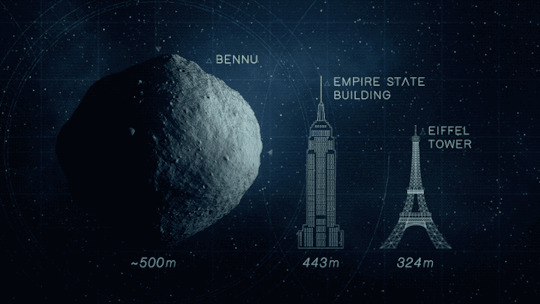
Asteroids spin on their axes just like Earth does. Small ones, with diameters of 200 meters or less, often spin very fast, up to a few revolutions per minute. This rapid spinning makes it difficult for a spacecraft to match an asteroid's velocity in order to touch down and collect samples. Even worse, the quick spinning has flung loose rocks and soil, material known as "regolith" — the stuff OSIRIS-REx is looking to collect — off the surfaces of small asteroids. Bennu’s size, in contrast, makes it approachable and rich in regolith. It has a diameter of 492 meters, which is a bit larger than the height of the Empire State Building in New York City, and rotating once every 4.3 hours.
3. It's really old
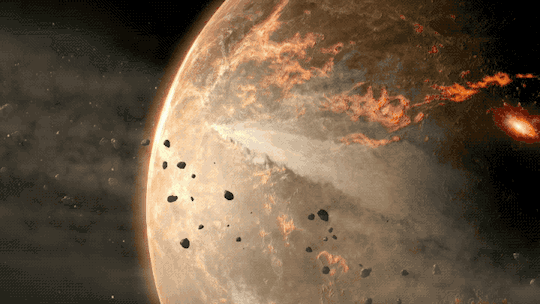
Bennu is a leftover fragment from the tumultuous formation of the solar system. Some of the mineral fragments inside Bennu could be older than the solar system. These microscopic grains of dust could be the same ones that spewed from dying stars and eventually coalesced to make the Sun and its planets nearly 4.6 billion years ago. But pieces of asteroids, called meteorites, have been falling to Earth's surface since the planet formed. So why don't scientists just study those old space rocks? Because astronomers can't tell (with very few exceptions) what kind of objects these meteorites came from, which is important context. Furthermore, these stones, that survive the violent, fiery decent to our planet's surface, get contaminated when they land in the dirt, sand, or snow. Some even get hammered by the elements, like rain and snow, for hundreds or thousands of years. Such events change the chemistry of meteorites, obscuring their ancient records.
4. It's well preserved
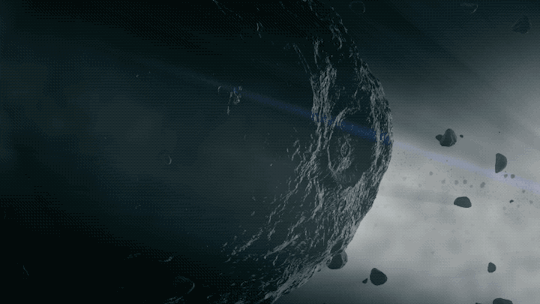
Bennu, on the other hand, is a time capsule from the early solar system, having been preserved in the vacuum of space. Although scientists think it broke off a larger asteroid in the asteroid belt in a catastrophic collision between about 1 and 2 billion years ago, and hurtled through space until it got locked into an orbit near Earth's, they don’t expect that these events significantly altered it.
5. It might contain clues to the origin of life
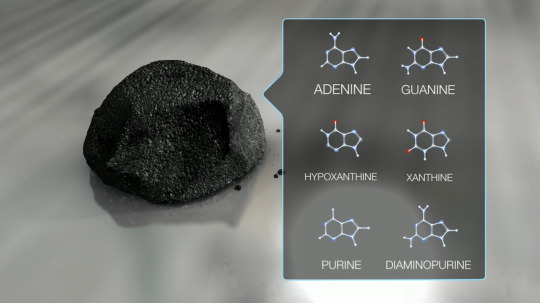
Analyzing a sample from Bennu will help planetary scientists better understand the role asteroids may have played in delivering life-forming compounds to Earth. We know from having studied Bennu through Earth- and space-based telescopes that it is a carbonaceous, or carbon-rich, asteroid. Carbon is the hinge upon which organic molecules hang. Bennu is likely rich in organic molecules, which are made of chains of carbon bonded with atoms of oxygen, hydrogen, and other elements in a chemical recipe that makes all known living things. Besides carbon, Bennu also might have another component important to life: water, which is trapped in the minerals that make up the asteroid.
6. It contains valuable materials

Besides teaching us about our cosmic past, exploring Bennu close-up will help humans plan for the future. Asteroids are rich in natural resources, such as iron and aluminum, and precious metals, such as platinum. For this reason, some companies, and even countries, are building technologies that will one day allow us to extract those materials. More importantly, asteroids like Bennu are key to future, deep-space travel. If humans can learn how to extract the abundant hydrogen and oxygen from the water locked up in an asteroid’s minerals, they could make rocket fuel. Thus, asteroids could one day serve as fuel stations for robotic or human missions to Mars and beyond. Learning how to maneuver around an object like Bennu, and about its chemical and physical properties, will help future prospectors.
7. It will help us better understand other asteroids
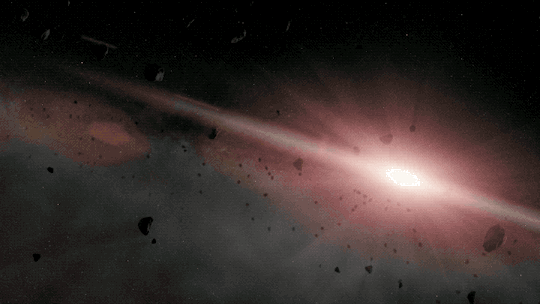
Astronomers have studied Bennu from Earth since it was discovered in 1999. As a result, they think they know a lot about the asteroid's physical and chemical properties. Their knowledge is based not only on looking at the asteroid, but also studying meteorites found on Earth, and filling in gaps in observable knowledge with predictions derived from theoretical models. Thanks to the detailed information that will be gleaned from OSIRIS-REx, scientists now will be able to check whether their predictions about Bennu are correct. This work will help verify or refine telescopic observations and models that attempt to reveal the nature of other asteroids in our solar system.
8. It will help us better understand a quirky solar force ...
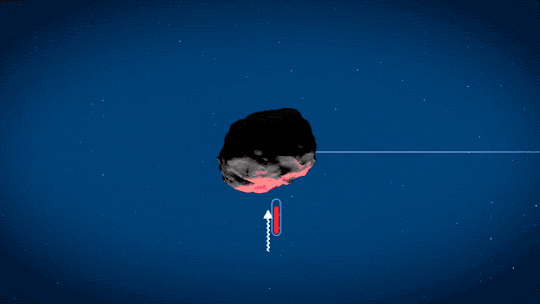
Astronomers have calculated that Bennu’s orbit has drifted about 280 meters (0.18 miles) per year toward the Sun since it was discovered. This could be because of a phenomenon called the Yarkovsky effect, a process whereby sunlight warms one side of a small, dark asteroid and then radiates as heat off the asteroid as it rotates. The heat energy thrusts an asteroid either away from the Sun, if it has a prograde spin like Earth, which means it spins in the same direction as its orbit, or toward the Sun in the case of Bennu, which spins in the opposite direction of its orbit. OSIRIS-REx will measure the Yarkovsky effect from close-up to help scientists predict the movement of Bennu and other asteroids. Already, measurements of how this force impacted Bennu over time have revealed that it likely pushed it to our corner of the solar system from the asteroid belt.
9. ... and to keep asteroids at bay

One reason scientists are eager to predict the directions asteroids are drifting is to know when they're coming too-close-for-comfort to Earth. By taking the Yarkovsky effect into account, they’ve estimated that Bennu could pass closer to Earth than the Moon is in 2135, and possibly even closer between 2175 and 2195. Although Bennu is unlikely to hit Earth at that time, our descendants can use the data from OSIRIS-REx to determine how best to deflect any threatening asteroids that are found, perhaps even by using the Yarkovsky effect to their advantage.
10. It's a gift that will keep on giving
Samples of Bennu will return to Earth on September 24, 2023. OSIRIS-REx scientists will study a quarter of the regolith. The rest will be made available to scientists around the globe, and also saved for those not yet born, using techniques not yet invented, to answer questions not yet asked.
Read the web version of this week’s “Solar System: 10 Things to Know” article HERE.
Make sure to follow us on Tumblr for your regular dose of space: http://nasa.tumblr.com.
#nasa#space#10things#bennu#Osiris-Rex#planets#asteroid#earth#universe#exploration#science#astronomy#spaceprobe#solarsystem
3K notes
·
View notes
Video
DÜNYANIN SONU MU? Nasa Açıkladı! DEV Meteor 29 NISAN 2020 KIYAMET
Dünya nın sonu mu? Kıyamet gibi Nasa açıkladı! Dev meteor (1998RO2 astroid) 29 Nisan 2020 de Dünya ya göktaşı çarpma ihtimali bulunuyor. Kıyamet alametleri gerçekleşiyor mu? Dünya'ya Göktaşı Çarpacak Mı? Meteor Çarpacak Mı? Dünyaya Göktaşı Ne Zaman Çarpacak? 29 nisan'da ne olacak? 1998OR2 ve 2009JF1 adı verilen iki farklı meteor. Peki bu haberler ne kadar doğru? 29 nisanda dünyanın sonu mu geliyor? sorularına cevap arıyorsanız bu video tam size göre!
► ÜCRETSİZ ABONE OL.!
►HZ MEHDİ YAKLAŞAN KIYAMET 2020 - Mesih Hz İsa, Deccal,
Dünyada olduğu kadar, Türkiye’de de göktaşı çarpması ile ilgili sosyal medyada binlerce paylaşım yapılırken, 29 Nisan'da dev bir asteroidin Dünya'ya çarpacak olması özellikle uzay meraklılarını olduğu kadar son günlerde bu korku havasını kullanmak isteyenlerede malzeme oluyor. Aslında herkesin atladığı önemli bir nokta var dünyaya 1 değil 2 meteor birden yaklaşıyor. 1998OR2 ve 2009JF1 adı verilen iki farklı meteor. Peki bu haberler ne kadar doğru? 29 nisanda dünyanın sonu mu geliyor?
NASA'dan flaş açıklama! Dünyaya meteor mu çarpacak?
Meteorun dünyaya çok yakın bir seyir içerisinde olduğunu duyuran NASA, nisan ayında meteorun daha da yakın bir seyir içerisinde olacağını ifade etti...
NASA'nın Kaliforniya'daki dünya yakınındaki cisimleri otomatik olarak takibe alan sistemi tarafından izlenen meteorun 4,1 km genişliğinde olduğu kaydedildi...
Bu büyüklükteki bir cismin dünyaya çarpması halinde dünya üzerinde insan yaşamının devam etmesinin mümkün olmadığını açıklayan bilim insanları, 1 km genişliğindeki bir meteorun bile küresel düzeyde insanlığın sonunu getirebileceğini ifade ediyor...
Saniyede 8,7 km, saatte 31 bin 320 km hızla yol alan meteorun dünyaya en yakın geçişi 29 Nisan'da gerçekleştirecek...
1998 OR2 ilk kez 1987 yılında Güneş'in etrafında dönerken görüldü ve yörüngesi NASA tarafından kaydedildi...
DÜNYA NIN SONU MU? Nasa Açıkladı! DEV Meteor 29 NISAN 2020 KIYAMET GİBİ
The Virtual Telescope, 6 Mart 2020'de asteroidin bir fotoğrafı da çekti. Fotoğrafın çekildiği tarihte göktaşı, dünyadan yaklaşık 36 milyon kilometre uzaklıktaydı. 29 Nisan'da ise, ay ile dünya arası mesafeden 16 kat daha fazla olan 6,3 milyon kilometre kadar yaklaşması bekleniyor. Bu mesafenin çok yüksek olduğu, bu yüzden göktaşının bir sorun olarak görünmediği ifade ediliyor.
GÖKTAŞI NEDİR?
Göktaşı ya da meteorit, uzaydan Dünya yüzeyine düşen maddelerin genel adıdır. Meteorit düşen nesnenin katı bir kalıntısıdır. Bu nesnekuyruklu yıldız, asteroit veya meteordur.
Tüm dünya NASA'nın yaptığı açıklamayı konuşuyor. NASA, Dünya'ya yaklaşmakta olan bir asteroid olduğunu duyurdu. Yapılan açıklamaya göre bu gök taşının rotasında sapma olmazsa 2022'de Dünya'ya çarpacak. TAM TARİHİ 6 MAYIS 2022. 2009JF1 adı verilen gök taşı, Mısır'daki Keops Piramidi büyüklüğünde olduğu söyleniyor. İddaalar bir anda tüm sosyal medyayı sallarken teyit.org ise bu bilgilerin tamamen hatalı olduğunu dile getirdi. Peki gerçekler ne?
Dünya’ya her 2000 yılda bir asteroitin isabet ettiğini belirten NASA, şu anda 2009JF1 kod adını verdikleri bir asteroitin mevcut rotasında devam etmesi durumunda Dünya’ya çarpacağını ve bu asteroitin çok yakın zamanda çarpabileceğini belirtti.
Bahsi geçen asteroitin 128 metrelik bir çapa sahip olduğunu belirten yetkililer, mevcut rotasında devam etmesi halinde 6 Mayıs 2022 tarihinde Dünya’ya çarpacağını ve bir şehri birkaç saniye içerisinde yok edebilecek bir potansiyele sahip olduğunu belirttiler.
Aynı rotasında ilerlemesi halinde yaklaşık 2 yıl sonra Dünya’ya çarpması beklenen dev asteroid in hangi ülkeye düşeceği hakkında bilgi verilmezken, konuyla ilgili açıklama yapan NASA dışı uzmanlar, 2009JF1 isimli asteroitin teğet geçme ihtimalinin de var olduğunu belirttiler.
Nisan 2020 de Dünya nın 6.3 milyon kilometre yakınından geçip yörüngesindeki hareketine devam edecek olan 1998OR2, bu mesafeden geçmesi halinde Dünya üzerinde herhangi bir etkiye sahip olmayacak.
Ancak çok sayıda değişken parametrenin var olduğu yörüngede, asteroidin yörüngesindeki bir değişiklikle Dünya’ya çarpma ihtimali de her zaman varlığını sürdürecek.
Polonya asıllı gökbilimci Ivan Yarkovsky’nin ortaya koyduğu çalışmaya göre, Yarkovsky Etkisi adı verilen teori gerçekleşebilir ve bir radyasyon kuşağı asteroidin sıcaklığında değişime sebep olarak yönünü değiştirebilir.
Yerçekimsel anahtar deliği olarak isimlendirilen başka bir bilimsel gerçek ise, asteroidin bir gezegenin çekim alanına girerek yörüngesinde değişikliğe neden olabileceğini ortaya koyuyor.
► 3.Göz, Kalp gözü, Göz perdesi Nasıl Açılır?
► Göz perdesi kalkarsa ne görürüz? Kuran Büyük Sır
► KIYAMET İÇİN ALLAH'A ? Hz İsa, Mehdi, Deccal
► #meteor #türkiye #dünya #uzay #astreoid
► İletişim ; [email protected]
bakmış,2020 kehanetleri,kıyamet,kıyamet alametleri,nasa,dev,meteor,29 nisan 2020,nisan,nasa açıkladı,uzay,1998OR2,2009jf1,astroid,göktaşı,dünya,nasa uyardı göktaşı,nasa meteor 2020,29 nisan'da ne olacak,2020 meteor,nasa asteroid,dünyanın sonu,dev meteor,nasa uyardı,türkiye,29 nisan,asteroid,dev asteroid,göktaşı çarpması,göktaşı düşmesi,kıyamet günü,kıyamet yaklaşıyor,2020,dünyanın sonu mu,dev meteor 2020,kuran,2020 kıyamet,açıkladı,trend,meteor düştü
#2020 kehanetleri#kıyamet#kıyamet alametleri#nasa#dev#meteor#29 nisan 2020#nisan#nasa açıkladı#uzay#1998OR2#2009jf1#asiático#göktaşı#dünya#nasa uyardı#nasa uyardı göktaşı#nasa meteor#nasa meteor 2020#2020#29 nisan ne olacak#2020 meteor#nasa asteroid#dünyanın sonu#dev meteor#türkiye#29 nisan#asteroid mining#dev asteroid#göktaşı çarpması
1 note
·
View note
Text
“Jesus was crucified on an asparagus, like a really big asparagus.”
@yarkovsky
5 notes
·
View notes
Text
Hubble watches spun-up asteroid coming apart
A small asteroid has been caught in the process of spinning so fast it's throwing off material, according to new data from NASA's Hubble Space Telescope and other observatories.

Images from Hubble show two narrow, comet-like tails of dusty debris streaming from the asteroid (6478) Gault. Each tail represents an episode in which the asteroid gently shed its material -- key evidence that Gault is beginning to come apart.
Discovered in 1988, the 2.5-mile-wide (4-kilometer-wide) asteroid has been observed repeatedly, but the debris tails are the first evidence of disintegration. Gault is located 214 million miles (344 million kilometers) from the Sun. Of the roughly 800,000 known asteroids between Mars and Jupiter, astronomers estimate that this type of event in the asteroid belt is rare, occurring roughly once a year.
Watching an asteroid become unglued gives astronomers the opportunity to study the makeup of these space rocks without sending a spacecraft to sample them.
"We didn't have to go to Gault," explained Olivier Hainaut of the European Southern Observatory in Germany, a member of the Gault observing team. "We just had to look at the image of the streamers, and we can see all of the dust grains well-sorted by size. All the large grains (about the size of sand particles) are close to the object and the smallest grains (about the size of flour grains) are the farthest away because they are being pushed fastest by pressure from sunlight."
Gault is only the second asteroid whose disintegration has been strongly linked to a process known as a YORP effect. (YORP stands for "Yarkovsky-O'Keefe-Radzievskii-Paddack," the names of four scientists who contributed to the concept.) When sunlight heats an asteroid, infrared radiation escaping from its warmed surface carries off angular momentum as well as heat. This process creates a tiny torque that can cause the asteroid to continually spin faster. When the resulting centrifugal force starts to overcome gravity, the asteroid's surface becomes unstable, and landslides may send dust and rubble drifting into space at a couple miles per hour, or the speed of a strolling human. The researchers estimate that Gault could have been slowly spinning up for more than 100 million years.
Piecing together Gault's recent activity is an astronomical forensics investigation involving telescopes and astronomers around the world. All-sky surveys, ground-based telescopes, and space-based facilities like the Hubble Space Telescope pooled their efforts to make this discovery possible.
The initial clue was the fortuitous detection of the first debris tail, observed on Jan. 5, 2019, by the NASA-funded Asteroid Terrestrial-Impact Last Alert System (ATLAS) telescope in Hawaii. The tail also turned up in archival data from December 2018 from ATLAS and the Panoramic Survey Telescope and Rapid Response System (Pan-STARRS) telescopes in Hawaii. In mid-January, a second shorter tail was spied by the Canada-France-Hawaii Telescope in Hawaii and the Isaac Newton Telescope in Spain, as well as by other observers. An analysis of both tails suggests the two dust events occurred around Oct. 28 and Dec. 30, 2018.
Follow-up observations with the William Herschel Telescope and ESA's (European Space Agency) Optical Ground Station in La Palma and Tenerife, Spain, and the Himalayan Chandra Telescope in India measured a two-hour rotation period for the object, close to the critical speed at which a loose "rubble-pile" asteroid begins to break up.
"Gault is the best 'smoking gun' example of a fast rotator right at the two-hour limit," said team member Jan Kleyna of the University of Hawaii in Honolulu.
An analysis of the asteroid's surrounding environment by Hubble revealed no signs of more widely distributed debris, which rules out the possibility of a collision with another asteroid causing the outbursts.
The asteroid's narrow streamers suggest that the dust was released in short bursts, lasting anywhere from a few hours to a few days. These sudden events puffed away enough debris to make a "dirt ball" approximately 500 feet (150 meters) across if compacted together. The tails will begin fading away in a few months as the dust disperses into interplanetary space.
Based on observations by the Canada-France-Hawaii Telescope, the astronomers estimate that the longer tail stretches over half a million miles (800,000 kilometers) and is roughly 3,000 miles (4,800 kilometers) wide. The shorter tail is about a quarter as long.
Only a couple of dozen active asteroids have been found so far. Astronomers may now have the capability to detect many more of them because of the enhanced survey capabilities of observatories such as Pan-STARRS and ATLAS, which scan the entire sky. "Asteroids such as Gault cannot escape detection anymore," Hainaut said. "That means that all these asteroids that start misbehaving get caught."
The researchers hope to monitor Gault for more dust events.
19 notes
·
View notes